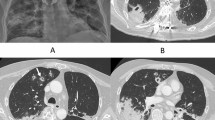Abstract
An allogeneic stem cell transplant recipient developed pulmonary infiltrates and Aspergillus antigenemia during prophylactic low–dose liposomal amphotericin B. No response to therapy was observed after increasing the dose of liposomal amphotericin B and addition of caspofungin, and breakthrough candidemia developed. Therapy switch to voriconazole did not prevent the development of lethal septic shock. Shortly before death, Scopulariopsis brevicaulis was cultured from bronchial secretions, and positive blood cultures demonstrated persistent candidemia due to Debaryomyces hansenii, teleomorph of Candida famata.
Similar content being viewed by others
Author information
Authors and Affiliations
Corresponding author
Additional information
This paper is dedicated to the founders of the Walter Marget Foundation, D. Adam and F. Daschner, in gratitude for their support of the training in infectious diseases.
Rights and permissions
About this article
Cite this article
Wagner, D., Sander, A., Bertz, H. et al. Breakthrough Invasive Infection Due to Debaryomyces hansenii (teleomorph Candida famata) and Scopulariopsis brevicaulis in a Stem Cell Transplant Patient Receiving Liposomal Amphotericin B and Caspofungin for Suspected Aspergillosis. Infection 33, 397–400 (2005). https://doi.org/10.1007/s15010-005-5082-4
Received:
Accepted:
Issue Date:
DOI: https://doi.org/10.1007/s15010-005-5082-4




